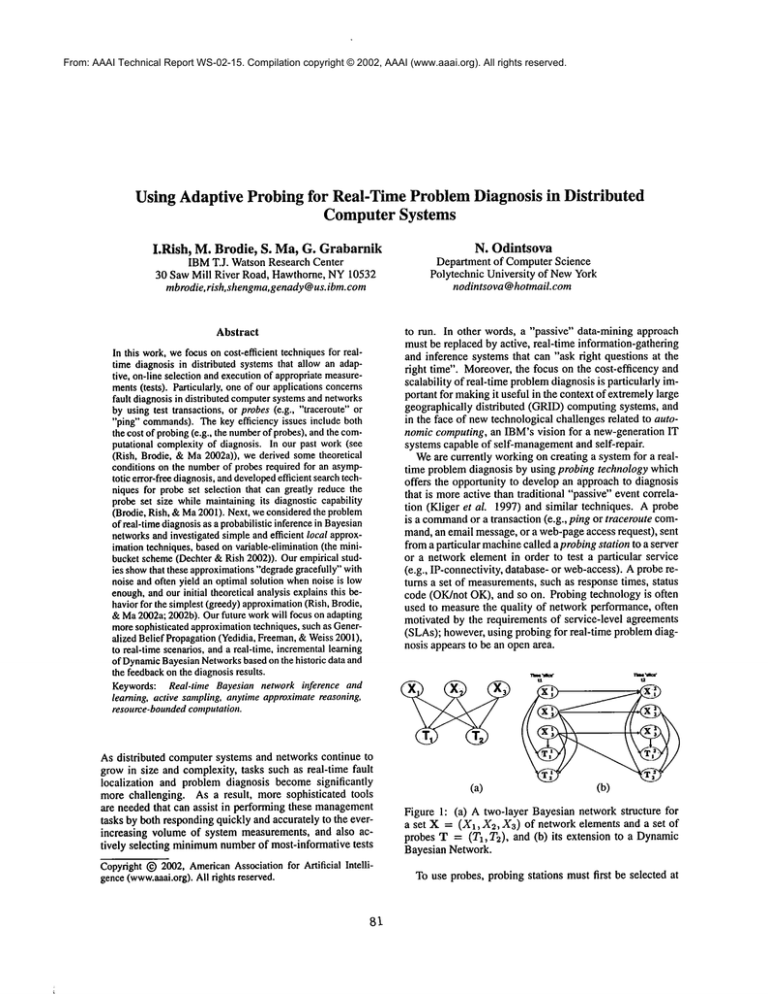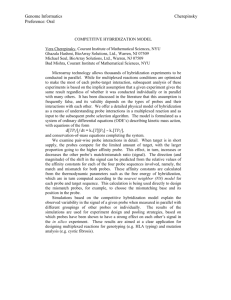
From: AAAI Technical Report WS-02-15. Compilation copyright © 2002, AAAI (www.aaai.org). All rights reserved.
Using Adaptive Probing for Real-Time Problem Diagnosis
Computer Systems
in Distributed
I.Rish, M. Brodie, S. Ma, G. Grabarnik
N. Odintsova
IBMT.J. Watson Research Center
30 Saw Mill River Road, Hawthorne, NY10532
mbrodie, rish, shengma,genady@us.ibm.com
Department of Computer Science
Polytechnic University of NewYork
nodintsova @hotmail.com
Abstract
In this work,wefocuson cost-efficient techniquesfor realtime diagnosis in distributed systemsthat allow an adaptive, on-line selectionandexecutionof appropriatemeasurements(tests). Particularly, oneof our applicationsconcerns
fault diagnosisin distributed computersystemsandnetworks
by using test transactions, or probes(e.g., "traceroute" or
"ping" commands).
Thekey efficiency issues include both
the cost of probing(e.g., the number
of probes),andthe computational complexityof diagnosis. In our past work(see
(Rish, Brodie, & Ma2002a)), we derived sometheoretical
conditions on the numberof probesrequired for an asymptotic error-freediagnosis,anddeveloped
efficient searchtechniques for probe set selection that can greatly reducethe
probe set size whilemaintainingits diagnostic capability
(Brodie, Rish, &Ma2001). Next,we consideredthe problem
of real-timediagnosisas a probabilisticinferencein Bayesian
networksandinvestigatedsimpleand efficient local approximationtechniques,basedon variable-elimination(the minibucket scheme(Dechter&Rish 2002)). Ourempiricalstudies showthat these approximations
"degradegracefully"with
noise and often yield an optimalsolution whennoise is low
enough,andour initial theoreticalanalysisexplainsthis behaviorfor the simplest(greedy)approximation
(Rish, Brodie,
&Ma2002a;2002b).Ourfuture workwill focus on adapting
moresophisticatedapproximation
techniques,suchas Generalized Belief Propagation(Yedidia,Freeman,&Weiss2001),
to real-timescenarios,anda real-time, incrementallearning
of Dynamic
BayesianNetworksbasedon the historic data and
the feedbackonthe diagnosisresults.
Keywords: Real-time Bayesian network inference and
learning, active samplh~g,anytimeapproximatereasoning,
resource-bounded
computation.
As distributed computer systems and networks continue to
growin size and complexity, tasks such as real-time fault
localization and problem diagnosis becomesignificantly
more challenging. As a result, more sophisticated tools
are needed that can assist in performing these management
tasks by both respondingquickly and accurately to the everincreasing volume of system measurements, and also actively selecting minimumnumberof most-informative tests
CopyrightI~) 2002, American
Associationfor Artificial Intelligence(www.aaai.org).
All rights reserved.
81
to run. In other words, a "passive" data-mining approach
must be replaced by active, real-time information-gathefing
and inference systems that can "ask fight questions at the
fight time". Moreover,the focus on the cost-efficency and
scalability of real-time problemdiagnosis is particularly important for makingit useful in the context of extremelylarge
geographically distributed (GRID)computing systems, and
in the face of newtechnological challenges related to autonomic computing, an IBM’svision for a new-generation IT
systems capable of self-managementand self-repair.
Weare currently workingon creating a system for a realtime problem diagnosis by using probing technology which
offers the opportunity to develop an approach to diagnosis
that is moreactive than traditional "passive" event correlation (Kliger et al. 1997) and similar techniques. A probe
is a cornmandor a transaction (e.g., ping or traceroute command,an email message, or a web-pageaccess request), sent
from a particular machinecalled a probingstation to a server
or a network element in order to test a particular service
(e.g., IP-connectivity, database- or web-access).A probe returns a set of measurements,such as response times, status
code (OK/not OK), and so on. Probing technology is often
used to measurethe quality of network performance, often
motivated by the requirements of service-level agreements
(SLAs); however, using probing for real-time problemdiagnosis appears to be an open area.
(a)
(b)
Figure 1: (a) A two-layer Bayesian network structure for
a set X = (X1,X2,Xa) of network elements and a set of
probes T = (T1,T2), and (b) its extension to a Dynamic
Bayesian Network.
To use probes, probing stations must first be selected at
one or more locations in the network. Then the probes
must be configured; it must be decided which network elements to target and whichstation each probe should originate from. Using probes imposes a cost, both because of
the additional network load that their use entails and also
because the probe results must be collected, stored and analyzed. Cost-effective diagnosis requires a small probe set,
yet the probe set must also provide wide coverage, in order
to locate problems anywherein the network. By reasoning
about the interactions amongthe probe paths, we construct
an estimate of the information gain provided by each probe,
and use this estimate as a probe selection heuristic. This
yields a quadratic-time greedy-search algorithm whichfinds
near-optimal probe sets. Wealso implement a linear-time
algorithm which can be used to find small probe sets very
quickly; a reduction of almost 50%in the probe set size
is achieved. The results are reported in (Brodie, Rish,
Ma2001; Rish, Brodie, & Ma2002b). Moreover, in (Rish,
Brodie, & Ma2002a) we provide some theoretical bounds
on the diagnosis error and derive necessary conditions on
the numberof probes required for an asymptotically errorfree diagnosis.
Oncethe probes have been selected and sent, fault diagnosis is performedby analyzing the probe outcomes.In reallife scenarios this must be done in an environmentof noise
and uncertainty. For example, a probe can fail even though
all the nodes it goes through are OK(e.g., due to packet
loss). Conversely, there is a chance that a probe succeeds
even if a node on its path has failed (e.g., dynamicrouting
mayresult in the probe followinga different path). Thusthe
task is to determinethe mostlikely configurationof the states
of the network elements.
Weuse the graphical framework of Bayesian networks
(Pearl 1988) that provides both a compactfactorized representation for multivariate probabilistic distributions as well
as a convenient tool for probabilistic inference. Anexample
of a simple Bayesian network (BN)for problemdiagnosis
shownin Figure la: a is bipartite (two-layer) graph where
the top-layer nodes represent marginally independentfaults
or other problems(if the problemsare not marginally independent, appropriate edges must be added between them)
and the bottom-layer nodes represent probe results. In order to represent temporal dependencies, such network can
be extended to a k-slice DynamicBayesian Network where
each time-slice contains a copy of the above BN,and interslice dependenciesare encodedby transition probabilities,
as shownin Figure lb (see (Rish, Grabamik, & Odintsova
2002)for details).
Since the exact inference in large Bayesian networks is
often intractable (NP-hard), weinvestigated the applicability of approximation techniques. The complexity of inference is usually associated with large probabilistic dependencies recorded during inference (clique size, or induced
width)(Dechter 1996). Thus, a popular approximation approach is to restrict the complexityby focusing only on local interactions. Weinvestigated the performance of two
local inference techniques, greedy-mpeand approx-mpe(1),
which are the simplest membersof the parametric family
of variable-elimination algorithms knownas mini-bucket ap-
proximations (Dechter & Rish 2002). Our empirical studies showthat these approximations "degrade gracefully"
with noise and often yield an optimal solution whennoise
is low enough,and our initial theoretical analysis explains
this behavior for the simplest (greedy) approximation(Rish,
Brodie, & Ma2002a; 2002b). The mini-bucket scheme is
closely related to other local approximations,such as iterative belief propagation(IBP) and generalized belief propagation (GBP)algorithms (Yedidia, Freeman, &Weiss 2001).
Weplan to investigate those approximation approaches in
our future work and hope to extend our analysis of the
mini-bucket schemethat can be viewed as simplified, noniterative version of those state-of-the-art approaches.
Finally, there are several directions for future workweare
planning to pursue:
¯ adaptiveprobing- i.e. adjusting the probe set dynamically
in response to the state of the network;
¯ extending local approximation techniques (mini-buckets,
GBP)to incremental, real-time scenarios;
¯ handling intermittent failures, dynamicrouting, and other
non-stationarities in the network state and behavior; the
latter wouldrequire tuning the model, i.e. online learning, which can be also done actively by using probe selection to improvelearning (e.g., only update the part of
the modelwhichis currently relevant).
References
Brodie, M.;Rish, I.; and Ma,S. 2001.Optimizingprobe selection for fault localization. In DistributedSystemsOperationand
Management.
Dechter,R., andRish, I. 2002.Mini-buckets:AGeneralScheme
for Approximating
Inference. To appearin J. of ACM.
Dechter,R. 1996. Bucketelimination: A unifying framework
for
probabilistic inference. In Proc.TwelfthConf.on Uncertaintyin
Artifurial Intelligence,211-219.
Kliger, S.; Yemini,S.; Yemini,Y.; Ohsie,D.; andStolfo, S. 1997.
A codingapproachto event correlation. In Intelligent Network
Management
(IM).
Pearl, J. 1988.ProbabilisticReasoningin Intelligent Systems.
MorganKaufmann.
Rish, I.; Brodie,M.;and Ma,S. 2002a.Accuracyvs. Efficiency
Trade-offsin Probabilistic Diagnosis.In To appearin the Proceedingsof the The EighteenthNationalConferenceon Artificial
Intelligence (AAAI2002
), Edmonton,
Alberta, Canada.
Rish, I.; Brodie, M.; and Ma,S. 2002b.Intelligent probing:
a Cost-Efficient Approachto Fault Diagnosisin Computer
Networks.Submittedto IBMSystemsJournal.
Rish, I.; Grabarnik, G.; and Odintsova, N. 2002. Dynamic
BayesianNetworkApproachto Real-timeProblemDiagnosisusing Probing.Technicalreport, IBMT.J. WatsonResearchCenter.
Yedidia, J.; Freeman,W.T.; and Weiss, Y. 2001. Generalized
belief propagation.In NIPS13, 689-695.MITPress.
82







